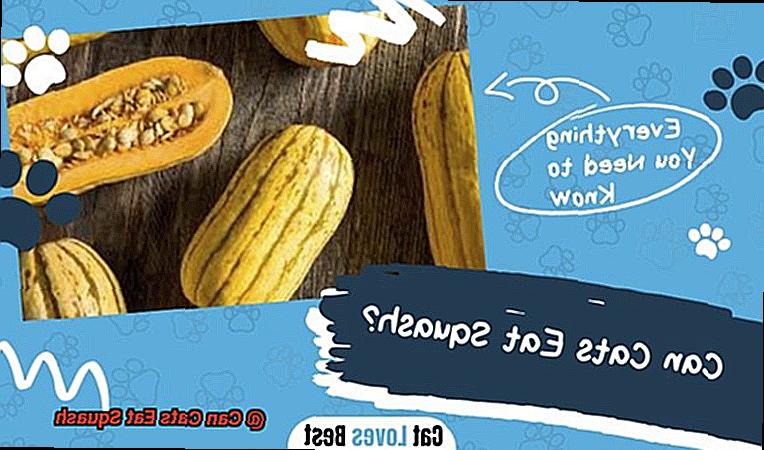Have you ever wondered if your kitty can munch on the same foods as you? If you’re contemplating sharing your butternut squash dinner with your feline friend, hold up. Before you do, let’s explore whether it’s safe for cats to consume this veggie.
Squash is a nutrient-dense vegetable that’s both delicious and healthy. It’s a staple in many households and a popular ingredient in various dishes. But can cats eat squash? The answer isn’t straightforward.
As an expert in pet nutrition, I’ve delved into extensive research on the topic and discovered some essential information that every cat owner should know about squash and cats. From potential health benefits to possible risks, we’ll cover everything in this article.
However, keep in mind that not all cats are created equal. Every feline has unique dietary needs and sensitivities, which is why consulting with a veterinarian before introducing any new food is critical. So let’s dive into whether cats can eat squash and what to consider before feeding it to your furry friend.
What Is Squash?
Squash is not just a human favorite, it’s also a great addition to your cat’s diet. However, before you start adding squash to their meals, there are some important things that you need to keep in mind.

Firstly, what is squash exactly? Squash is a type of vegetable that belongs to the Cucurbitaceae family, which also includes popular vegetables such as pumpkins, cucumbers, and zucchinis. Squash comes in many different varieties, including butternut squash, acorn squash, spaghetti squash, and summer squash. It’s a rich source of vitamins A and C, dietary fiber, antioxidants, and anti-inflammatory compounds that can benefit your cat’s overall health.
But not all types of squash are safe for cats to eat. Some have a hard outer shell that can be difficult for cats to digest. And some are high in carbohydrates and may not be suitable for cats who are on a low-carb diet. That’s why it’s crucial to know which types of squash are safe for your cat and how much they should eat.
If you want to add squash to your cat’s diet, only give them the flesh of the vegetable. The stem and leaves of the plant may contain toxins that could harm your cat. Also, make sure to cook and mash or puree the squash before feeding it to them. This will make it easier for them to digest and prevent any choking hazards.
It’s best to introduce squash slowly into your cat’s diet and monitor their reaction for any signs of an adverse reaction. While some cats may enjoy eating small amounts of cooked squash as a treat, it should not make up a significant portion of their diet.
Nutritional Benefits of Squash for Cats
First and foremost, squash is an excellent source of fiber, which is essential for maintaining healthy digestion and preventing constipation in cats. A healthy digestive system can help your cat avoid discomfort and maintain regular litter box habits.
Squash is also rich in vitamins A, C, and E, which are powerful antioxidants that help boost the immune system and promote healthy skin and coat in cats. Your furry friend will not only feel great on the inside but also look amazing on the outside.
In addition to these benefits, squash is an excellent source of potassium, which plays a vital role in maintaining healthy muscle and nerve function in cats. It can help regulate blood pressure levels, heart function, and fluid balance in your pet’s body.
Moreover, squash is low in calories and fat, making it an ideal food choice for overweight or obese cats. Additionally, it is a low-glycemic food that can benefit diabetic cats by having minimal effects on their blood sugar levels.
To sum it up, squash is a highly nutritious vegetable that offers numerous health benefits to cats. Its high fiber content promotes healthy digestion, while vitamins A, C, and E support the immune system and promote healthy skin and coat.
Potassium helps maintain healthy muscle and nerve function, while its low-calorie and low-fat content make it an ideal food option for overweight or obese cats.
However, as with any new food item, it is crucial to introduce squash gradually into your cat’s diet while monitoring their reaction.
Always consult with your veterinarian before making any dietary changes to ensure your feline friend’s specific needs are met.
Potential Risks of Feeding Squash to Cats
Unfortunately, when it comes to feeding squash to cats, there are potential risks that must be considered.
One of the primary concerns with feeding squash to cats is its high fiber content. While fiber can be beneficial for regulating a cat’s digestive system, too much of it can cause problems such as vomiting, diarrhea, or constipation.
This is because cats are obligate carnivores and their digestive systems are not equipped to handle large amounts of plant matter. Therefore, it’s important to monitor your cat’s intake of squash and other high-fiber foods.
In addition to digestive issues, squash also contains a high level of carbohydrates which can lead to weight gain in cats. Overweight cats are more prone to developing health problems such as diabetes, heart disease, and joint problems.
It’s crucial to keep an eye on your cat’s weight and limit their intake of high-carbohydrate foods such as squash.
Furthermore, certain types of squash contain toxic compounds called cucurbitacins. These compounds can cause severe gastrointestinal distress and even lead to liver damage in cats. It’s best to avoid feeding bitter gourd, pumpkin, and zucchini altogether as they are known to have high levels of cucurbitacins.
How to Prepare Squash for Cats
If you’re thinking about adding squash to your cat’s diet, preparation is key to ensure that it’s safe and enjoyable for your furry friend. Here are five simple steps to prepare squash for cats:
Wash and Clean the Squash Thoroughly
Before preparing the squash, make sure to wash and clean it thoroughly. This will help remove any dirt or bacteria that may be present on the skin.
Remove the Seeds and Peel
The seeds of the squash can be toxic to cats and cause digestive issues or even poisoning. Additionally, the tough outer peel can be difficult for cats to digest. So, it’s best to remove both the seeds and peel before feeding them squash.
Cook the Squash
Raw squash can be difficult for cats to digest and may cause gastrointestinal upset. It’s best to cook the squash by steaming, boiling, or baking it until it’s soft and tender.
Mash or Puree the Squash
Cats have small mouths and may have difficulty chewing large pieces of squash. To make it easier for them to eat, you can mash or puree the cooked squash into a smooth consistency.

Introduce Squash Slowly
If your cat has never eaten squash before, it’s important to introduce it slowly to avoid any potential digestive issues. Start by offering a small amount of mashed or pureed squash mixed with their regular food.

Introducing Squash into Your Cat’s Diet
Squash might just be the answer. This versatile vegetable comes in many different varieties, including butternut, acorn, and spaghetti squash. Not only is it packed with vitamins and minerals that can benefit your cat’s health, but it can also be a tasty addition to their diet. However, before you start introducing squash to your cat, there are a few things you should know.
Firstly, it’s important to make sure your cat is not allergic to squash. Start by feeding them a small amount of cooked squash and observing their reaction. If they have an adverse reaction, such as vomiting or diarrhea, stop feeding them squash immediately and consult with your veterinarian.
Assuming your cat tolerates squash well, it’s crucial to prepare it properly. Remove the seeds and tough outer skin before cooking the squash until it’s soft and tender. Then, mash or puree the squash into a smooth consistency that’s easy for your cat to digest.
When it comes to serving squash to your cat, there are a few options. You can serve it as a treat on its own or mix it in with their regular food. However, keep in mind that squash should only make up a small portion of their overall diet. Cats are obligate carnivores and require a diet high in animal protein.
Introducing squash into your cat’s diet can provide them with some extra nutrients, but it should never replace their regular diet. Here are some tips on how best to add this vegetable to their meals:
- Check with your vet: Always consult with your veterinarian before making any changes to your cat’s diet.
- Test for allergies: Start with a small amount of cooked squash and observe their reaction.
- Prepare the squash properly: Remove the seeds and tough outer skin before cooking.
- Serve in moderation: Squash should only make up a small portion of your cat’s overall diet.
Monitor Your Cat’s Reaction
Adding new food to your cat’s diet can be a tricky business, but it doesn’t have to be. If you’re thinking about giving your cat squash, it’s essential to monitor their reaction closely. Squash is generally safe for cats to eat in small portions, but as with any new food, it’s crucial to introduce it gradually and observe your cat’s behavior and overall health.
Here are some key things to keep in mind when introducing squash to your cat’s diet:
- Watch for Your Cat’s Reaction: Keep an eye on how your cat reacts to the taste and texture of the squash. Some cats may love the flavor and eagerly gobble it up, while others may be hesitant or show disinterest. Additionally, pay attention to any signs of discomfort or digestive issues such as vomiting or diarrhea.
- Introduce Squash Gradually: It is recommended to introduce squash gradually and in small amounts. Start by offering a small piece of cooked squash as a treat and gradually increase the portion size over time. This will allow your cat’s digestive system to adjust to the new food without causing any upset stomachs or potential allergies.
- Monitor Changes in Behavior or Health: Be mindful of any changes in your cat’s behavior or health after consuming squash. If you notice any unusual symptoms or reactions, consult with your veterinarian immediately. They can provide professional advice and guidance on whether squash is suitable for your cat’s specific dietary needs.
Other Vegetables That Are Safe for Cats
While it’s crucial to be aware of foods that can be harmful to cats, there are several safe vegetables that you can feed your feline friend.
Let’s start with green beans. Not only are they safe for cats, but they can also help improve their digestive system due to their high fiber content. Carrots are another fantastic vegetable option for cats as they are rich in vitamins and minerals like vitamin A, potassium, and beta-carotene.
If you’re looking to switch things up, cooked sweet potatoes are an excellent source of fiber, vitamin C, and beta-carotene. However, it’s crucial to ensure that the sweet potato is thoroughly cooked before feeding it to your cat. Leafy greens like spinach and kale are also safe for cats and provide essential vitamins and minerals like vitamin K, iron, and calcium.
In addition to these veggies, zucchini, cucumber, broccoli, and pumpkin are also safe options that you can feed your cat. However, it’s essential to remember that these vegetables should be given in moderation and as part of a balanced diet. Consulting with a veterinarian before introducing any new food items into your cat’s diet is always recommended.
YjAvyMWXH2Y” >
Conclusion
To sum up, squash can be a healthy addition to your cat’s diet, but it’s important to proceed with caution. Not all types of squash are safe for cats, and improper preparation can lead to digestive issues or weight gain. Additionally, some varieties contain toxic compounds that could harm your feline friend.
Before serving squash to your cat, consult with your veterinarian to determine if it’s a suitable option for their dietary needs. Your vet can also offer advice on how best to incorporate it into their meals.
As always, pay close attention to your cat’s reaction when introducing new foods. Start with small portions and monitor their behavior and overall health. If you notice any unusual symptoms or reactions, seek professional advice from your vet immediately.
In moderation, other vegetables like green beans, carrots, sweet potatoes, leafy greens such as spinach and kale, zucchini, cucumber, broccoli and pumpkin are also safe options that you can include in your cat’s diet.
Ultimately, prioritize your cat’s health by providing them with the proper nutrition they need to thrive.







